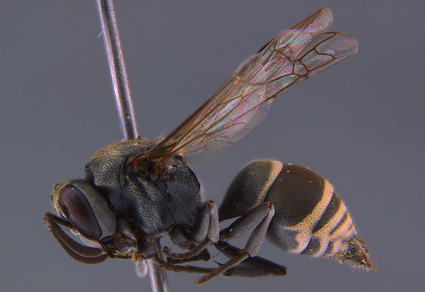Abstract
The Neotropical social wasp genus Chartergus is reviewed and comparative diagnoses, images of type material, and an updated identification key for species are presented. To investigate the phylogenetic relationships within the genus, we used a combined dataset of morphological characters, nest architecture traits, and molecular data. The results revealed the following relationships among the Chartergus species: (C. globiventris + (C. artifex + C. metanotalis)).
References
- Andena, S.R. & Carpenter, J.M. (2012) A phylogenetic analysis of the social wasp genus Brachygastra Perty, 1833, and description of a new species (Hymenoptera: Vespidae: Epiponini). American Museum Novitates, 3753, 1–38. https://doi.org/10.1206/3753.2
- Barroso, P.C.S., Menezes, R.S.T., Oliveira, M.L. & Somavilla, A. (2022) A systematic review of the Neotropical social wasp genus Angiopolybia Araujo, 1946 (Hymenoptera: Vespidae): species delimitation, morphological diagnosis, and geographical distribution. Arthropod Systematics & Phylogeny, 80 (2022), 75–97. https://doi.org/10.3897/asp.80.e71492
- Guindon, S., Dufayard, J.F., Lefort, V., Anisimova, M., Hordijk, W. & Gascuel, O. (2010) New algorithms and methods to estimate maximum-likelihood phylogenies: assessing the performance of PhyML 3.0. Systematic Biology, 59, 307–321. https://doi.org/10.1093/sysbio/syq010
- Goloboff, P.A., Farris, J.S., Kallersjo, M.B., Ramirez, M.J. & Szumika, C.A. (2003) Improvements to resampling measures of group support. Cladistics, 19, 324–332. https://doi.org/10.1111/j.1096-0031.2003.tb00376.x
- Goloboff, P.A., Farris, J.S. & Nixon, K.C. (2008) TNT, a free program for phylogenetic analysis. Cladistics, 24, 774–786. https://doi.org/10.1111/j.1096-0031.2008.00217.x
- Hoang, D.T., Chernomor, O., von Haeseler, A., Minh, B.Q. & Vinh, L.S. (2018) UFBoot2: Improving the ultrafast bootstrap approximation. Molecular Biology and Evolution, 35, 518–522. https://doi.org/10.1093/molbev/msx281
- Katoh, K., Rozewicki, J. & Yamada, K.D. (2019) MAFFT online service: multiple sequence alignment, interactive sequence choice and visualization. Briefings in Bioinformatics, 20, 1160–1166. https://doi.org/10.1093/bib/bbx108
- Lanfear, R., Frandsen, P.B., Wright, A.M., Senfeld, T. & Calcott, B. (2016) PartitionFinder 2: New Methods for Selecting Partitioned Models of Evolution for Molecular and Morphological Phylogenetic Analyses. Molecular Biology and Evolution, 34, 772–773. https://doi.org/10.1093/molbev/msw260
- Maddison, W.P. & Maddison, D.R. (2019) Mesquite: a modular system for evolutionary analysis. Version 3.61. Available from: http://www.mesquiteproject.org (accessed 22 January 2024)
- Menezes, R.S.T., Lloyd, M.W. & Brady, S.G. (2020) Phylogenomics indicates Amazonia as the major source of Neotropical swarm-founding social wasp diversity. Proceedings of the Royal Society B, 287(1928), 20200480. https://doi.org/10.1098/rspb.2020.0480
- Menezes, R.S.T., Noll, F.B., Aragão, M., Hermes, M.G. & Brady, S.G. (2023) Phylomitogenomics reveals mito-nuclear concordance in social wasps: The performance of mitochondrial markers and gene order for hymenopteran systematics. Systematics Entomology, 49 (1), 15–27. https://doi.org/10.1111/syen.12604
- Minh, B.Q., Nguyen, M.A. & von Haeseler, A. (2013) Ultrafast approximation for phylogenetic bootstrap. Molecular Biology and Evolution, 30, 1188–1195. https://doi.org/10.1093/molbev/mst024
- Minh, B.Q., Schmidt, H.A., Chernomor, O., Schrempf, D., Woodhams, M.D., von Haeseler, A. & Lanfear, R. (2020) IQ-TREE 2: New models and efficient methods for phylogenetic inference in the genomic era. Molecular Biology and Evolution, 37, 1530–1534. https://doi.org/10.1093/molbev/msaa015
- Noll, F.B., da Silva, M., Soleman, R.A., Lopes, R.B., Grandinete, Y.C., Almeida, E.A.B., Wenzel, J.W. & Carpenter, J.M. (2021) Marimbondos: systematics, biogeography, and evolution of social behaviour of neotropical swarm-founding wasps (Hymenoptera: Vespidae: Epiponini). Cladistics, 37, 423–441. https://doi.org/10.1111/cla.12446
- Richards, O.W. (1978) The social wasps of the Americas: excluding the Vespinae. British Museum (Natural History), London, 580 pp.
- Somavilla, A., Morais, Jr. R.N.M., Oliveira, M.L. & Rafael, J.R. (2020) Biodiversity of Insects in the Amazon: survey of social wasps (Vespidae: Polistinae) in Amazon rainforest areas in Amazonas state, Brazil. Sociobiology, 67, 312–321. https://doi.org/10.13102/sociobiology.v67i2.4061
- Somavilla, A., Barbosa, B.C., Souza, M.M. & Prezoto, F. (2021a) List of species of social wasps from Brazil. In: Prezoto, F., Nascimento, F.S., Barbosa, B.C. & Somavilla, A. (Eds.), Neotropical Social Wasps. Springer, Cham, pp. 293–316. https://doi.org/10.1007/978-3-030-53510-0_16
- Somavilla, A., Barroso, P.C.S., Aragão, M., Mateus, S. & Menezes, R.S.T. (2021b) An integrative taxonomic and phylogenetic approach reveals a new Neotropical swarm-founding social wasp, Pseudopolybia cryptica sp. n. (Vespidae: Polistinae: Epiponini). Arthropod Systematics & Phylogeny, 79 (2021), 25–35. https://doi.org/10.3897/asp.79.e64304
- Wenzel, J.W. (1998) A Generic Key to the Nests of Hornets, Yellowjackets, and Paper Wasps Worldwide (Vespidae: Vespinae, Polistinae). American Museum Novitates, 3224, 1–39.


